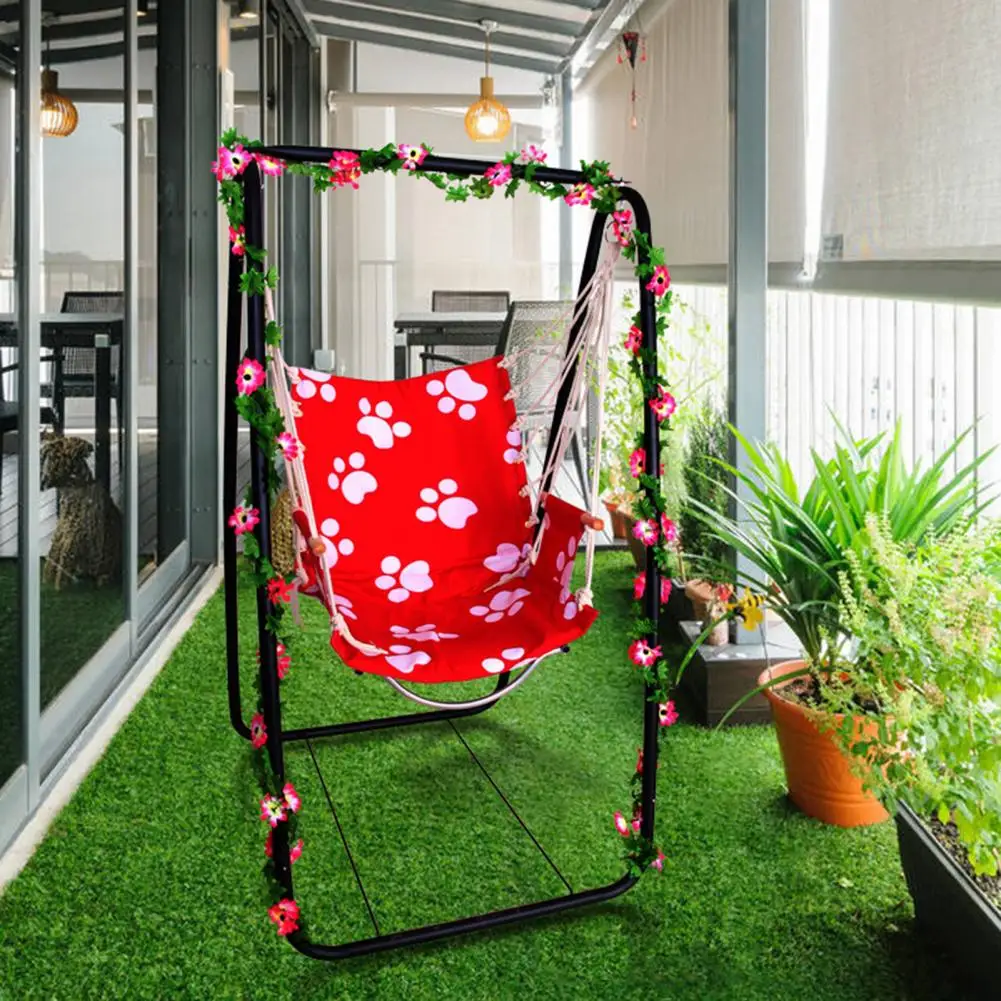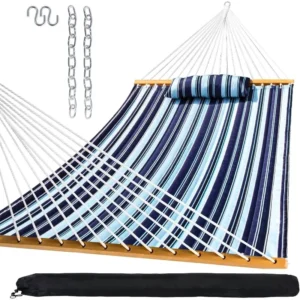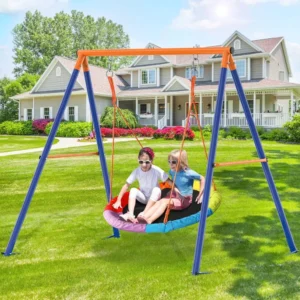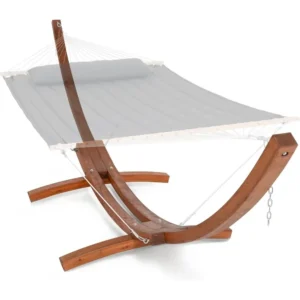Few things compare to the peaceful sensation of gently swaying in a hammock, but that serenity quickly disappears when your A-frame hammock stand starts wobbling, creaking, or worse—tipping over. Not only does an unstable hammock stand ruin your relaxation, but it also creates genuine safety concerns that can lead to injuries or damage to your hammock system.
Whether you’ve already experienced the frustration of a wobbly A-frame stand or want to prevent instability before it happens, this comprehensive guide will transform your hammock experience. We’ll explore the common causes of instability, provide practical solutions for rock-solid stability, and share essential safety precautions to ensure your hammock remains a source of joy rather than frustration.
By understanding the factors that contribute to stability issues and implementing our recommended solutions, you’ll be able to enjoy your hammock with complete confidence. Your indoor and outdoor hammock placement choices significantly impact stability, so we’ll cover that and much more to ensure your hammock stand remains firmly planted while you drift away in comfort.
Understanding the Wobble: Common Causes of A-Frame Hammock Instability
Before diving into solutions, it’s essential to understand why your A-frame hammock stand might be unstable. Identifying the root cause of wobbling or tipping is the first crucial step toward creating a stable, safe setup. Let’s examine the most common culprits behind A-frame hammock instability and how they compromise your relaxation experience.
Proper hammock installation requirements and safety guidelines form the foundation of a stable setup, but even minor oversights can lead to significant stability issues. By understanding these causes, you’ll be better equipped to diagnose and resolve your specific stability challenges.
The Ground Reality: Importance of a Level and Solid Foundation
The surface beneath your hammock stand plays a crucial role in its stability. An uneven or soft foundation is often the primary cause of wobbling and tipping.
Common ground-related stability issues include:
* Sloped terrain causing the stand to lean or shift
* Soft surfaces like sand, mud, or loose soil allowing the legs to sink unevenly
* Uneven surfaces creating pressure points on certain parts of the frame
* Shifting surfaces that don’t provide consistent support
When your hammock stand lacks a solid foundation, even the best-designed A-frame stand hammock sets will struggle to maintain stability under your weight.
Assembly Accuracy: Why Precision Matters
Even small assembly mistakes can dramatically impact your hammock stand’s stability. Many wobbling issues stem from improper assembly rather than design flaws. When components aren’t properly aligned or fasteners aren’t adequately tightened, the stand’s structural integrity becomes compromised.
Listen for creaking sounds when you use your hammock—these often indicate loose connections that need attention. Similarly, visible gaps between components that should fit snugly together suggest assembly problems that could lead to instability or even failure under load.
Material Integrity: Impact of Wear, Tear, and Age
Over time, exposure to the elements, regular use, and normal aging can degrade your hammock stand’s materials. This deterioration directly affects stability and safety.
Be on the lookout for:
* Rust or corrosion on metal components
* Splintering, cracking, or warping in wooden stands
* Stretched chains or ropes that alter the hammock’s hanging angle
* Worn or stripped bolt holes that no longer hold fasteners securely
* Bent metal components that compromise the stand’s geometry
These issues might develop gradually, making them easy to overlook until they cause significant stability problems.
Hammock Hanging Dynamics: How Your Hammock Affects the Stand
The way your hammock is hung on the stand significantly impacts overall stability. An improperly hung hammock can create unbalanced forces that make even a well-built stand wobble or tip.
The ideal suspension angle is approximately 30 degrees from horizontal. Angles that are too steep or too shallow place inappropriate stress on the stand structure. Similarly, spreader bar hammock sets distribute weight differently than traditional hammocks, requiring specific setup considerations to maintain stability.
If your hammock length doesn’t match your stand dimensions, you’ll struggle to achieve the proper hanging angle, further compromising stability.
Overloading: Exceeding Weight Capacity Limits
Each hammock stand has a maximum weight capacity that should never be exceeded. Overloading your stand doesn’t just risk breaking it—it dramatically increases instability before failure occurs.
It’s important to understand that safe hammock weight limits include both static weight (you sitting still) and dynamic weight (movement like getting in and out or swinging). Dynamic forces can multiply the effective weight placed on your stand, meaning even if you’re below the stated weight limit, certain movements might temporarily exceed it.
Multiple users in a hammock designed for single occupancy create particularly dangerous overloading situations that significantly compromise stability.
Safety First: Essential Precautions for Secure A-Frame Hammock Enjoyment
Before implementing stability solutions, understanding proper safety practices is crucial. These precautions help prevent accidents and ensure your hammock experience remains enjoyable and worry-free. Remember that stability and safety go hand-in-hand—a stable hammock stand is inherently safer, while following safety guidelines enhances stability.
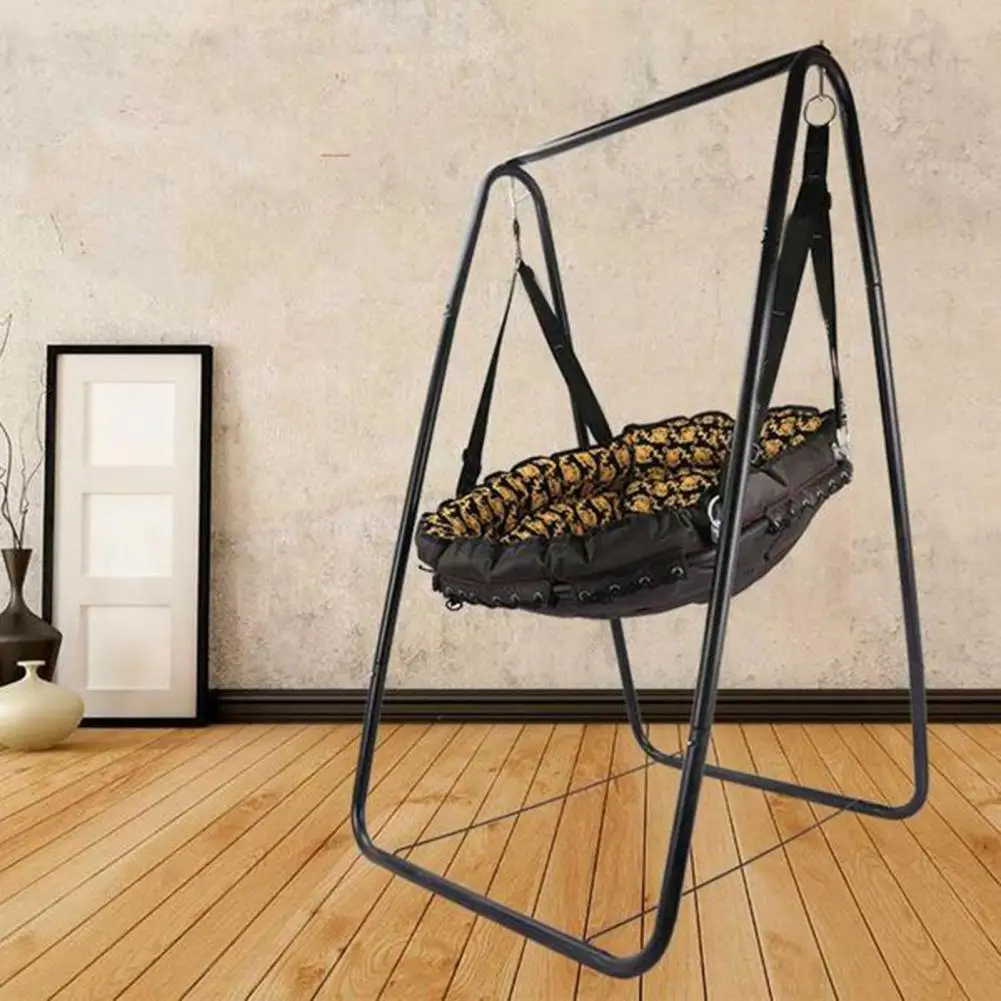
Know Your Limits: Adhering to Weight Capacities
Always verify and respect your hammock stand’s weight capacity. This information is typically found on product packaging, instruction manuals, or directly on the stand itself. For older stands where documentation might be missing, err on the side of caution and assume a conservative weight limit.
Remember that weight capacity includes everything—your body weight, the hammock itself, and any accessories like pillows or drink holders. When considering two-person hammocks, ensure your stand is specifically rated for multiple occupants rather than assuming it can handle double the weight.
Graceful Entry and Exit: Techniques to Prevent Tipping
How you get in and out of your hammock significantly impacts stability. Many tipping incidents occur during these transitions rather than during relaxed use.
For safer entry:
1. Position yourself at the center of the hammock
2. Place one hand on each edge of the hammock
3. Slowly lower your weight while keeping it centered
4. Avoid sudden movements or dropping your full weight at once
The same principles apply when exiting—move slowly, keep your weight centered, and use controlled movements. Proper indoor and outdoor hammock safety practices help prevent tipping incidents that could result in injury.
The Habit of Inspection: Regular Safety Checks
Develop a quick pre-use inspection routine to catch potential stability issues before they cause problems:
- Check that all bolts, nuts, and fasteners are tight
- Look for any visible damage to frame components
- Ensure the stand is level and all legs contact the ground evenly
- Verify that hanging points are secure and undamaged
- Check that the hammock itself has no tears or damaged attachment points
This simple habit takes just moments but can prevent accidents by identifying developing problems early.
Children and Pets: Ensuring Their Safety Around Hammocks
Special considerations apply when children or pets are around your hammock setup. Heavy duty hammock sets are designed with durability in mind, but even these require proper supervision with young users.
Always supervise children using hammocks and teach them proper entry, exit, and use techniques. For very young children, consider hammocks specifically designed for them rather than using adult versions.
Keep pets from climbing on or playing under occupied hammocks, as their movements can affect stability or create entanglement hazards. Be particularly cautious with hammocks with spreader bars, as these are more prone to tipping if weight isn’t properly centered.
Fortifying Your Setup: Practical Solutions for a Rock-Solid A-Frame Hammock Stand
Now that we understand what causes instability and the safety precautions to take, let’s explore practical solutions to create a rock-solid A-frame hammock setup. These recommendations progress from fundamental stability principles to enhancement options, allowing you to build a comprehensive approach to hammock stand stability.
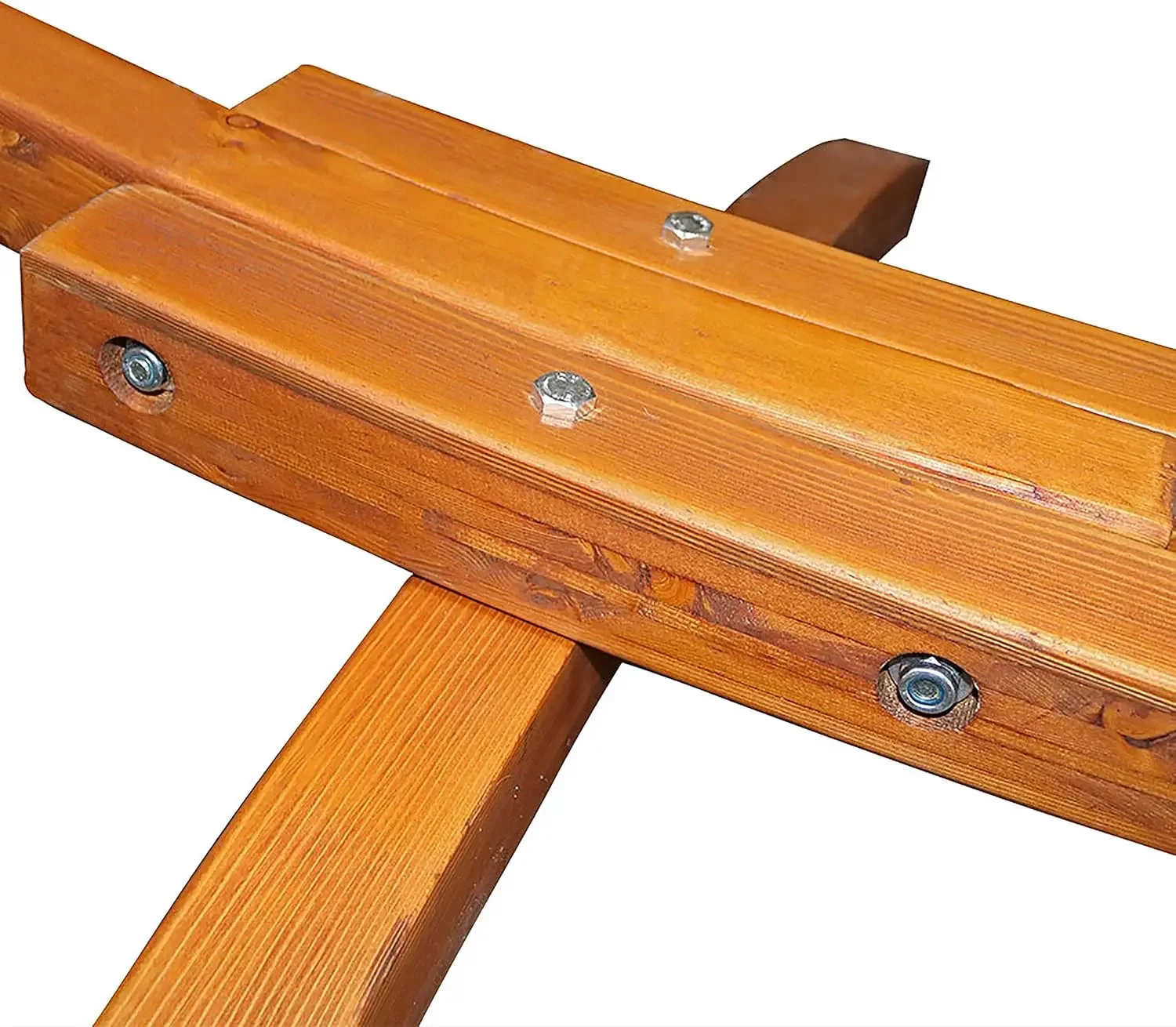
Site Selection: The Cornerstone of Stability
Choosing the right location for your hammock stand is perhaps the single most important factor for stability. The best indoor and outdoor hammock locations provide a solid foundation that supports the entire structure.
Look for these characteristics when selecting your hammock site:
* Flat, level ground without slopes or depressions
* Firm surface that won’t sink or shift under weight
* Adequate space for the full footprint of your stand plus additional clearance
* Protection from strong winds that could create lateral forces
If your desired location isn’t naturally ideal, consider these modifications:
* Use pavers or concrete blocks under stand feet to create a stable base
* Add interlocking deck tiles to distribute weight more evenly
* Install a dedicated gravel pad with compacted, level substrate
* Use leveling blocks to compensate for slight ground irregularities
Remember that different surfaces require different approaches—what works on a wooden deck might not be appropriate for a lawn setting.
Assembly & Maintenance: Tightening and Upkeep
Proper assembly and ongoing maintenance significantly impact stability. Follow these practices to ensure your stand remains structurally sound:
- Follow manufacturer instructions precisely, paying particular attention to component orientation
- Use a torque wrench when specified to achieve proper fastener tension
- Apply thread-locking compound on threaded connections that vibrate loose over time
- Use lock washers or nylon-insert lock nuts for critical connections
- Create a maintenance schedule with regular tightening of all fasteners
- Inspect connection points for wear and replace components before they fail
For wooden stands, periodically check and reseal any joints or fastener holes to prevent water infiltration that could lead to rot and structural weakness.
Perfecting the Hang: Hammock Adjustment for Optimal Stability
Achieving the ideal hammock hanging angle and position distributes forces correctly through your stand’s structure, dramatically improving stability.
For optimal stability:
* Adjust suspension to create approximately 30-degree angles from horizontal
* Set hammock height so it sits about 18 inches from the ground when occupied
* Center the hammock perfectly between the stand’s support points
* Ensure equal tension on both ends of the hammock
* Adjust the hammock’s “sag” or curve to distribute weight properly
Portable hammocks and stands often have specific adjustment mechanisms—familiarize yourself with these features to achieve ideal positioning.
Enhancements for Added Stability
Beyond basic setup, consider these enhancements to further improve your stand’s stability:
- Install rubber or silicone feet on stand legs to increase friction and prevent sliding
- Add weighted sandbags to stand legs in areas with occasional wind
- Install cross-braces or additional support bars for stands that allow modifications
- Use ground anchors for stands placed on softer outdoor surfaces
- Place anti-slip mats under stand feet for indoor use on hard floors
- Add stability straps that connect opposite legs for added rigidity
A-Frame Stand Hammock Sets, Swinging Hammock Chair Sets
$154.62 Select options This product has multiple variants. The options may be chosen on the product pageClassic Wooden Stand Hammock Sets, Heavy Duty Hammock Sets
$1,061.68 Select options This product has multiple variants. The options may be chosen on the product pageHammock Sets with Canopy, Heavy Duty Hammock Sets
$286.31 Select options This product has multiple variants. The options may be chosen on the product pageFolding Hammock Sets, Quick Setup Hammock Sets
Price range: $305.52 through $583.27 Select options This product has multiple variants. The options may be chosen on the product pageHeavy Duty Hammock Sets, Wooden Arc Stand Hammock Sets
$878.66 Select options This product has multiple variants. The options may be chosen on the product page
Building for Stability: DIY A-Frame Hammock Stand Design Essentials
For those interested in building their own A-frame hammock stand, understanding design principles that promote inherent stability is crucial. While this section doesn’t provide complete building plans, it offers essential engineering concepts to ensure your DIY stand remains stable and safe for years of enjoyment.
Selecting appropriate weatherproof A-frame hammock materials is essential for long-term stability, especially for stands that will live outdoors.
Structural Design Principles for Maximum Stability
The physics behind A-frame stability relies primarily on geometry and weight distribution. To ensure your DIY stand remains stable:
- Create a wide base—generally, the width of your A-frame base should be at least 50-60% of the height for optimal stability
- Use proper angles—the legs of the A-frame typically work best at 60-70 degrees from horizontal
- Incorporate triangulation wherever possible, as triangles are inherently stable structural forms
- Lower the center of gravity by using heavier materials for the base components
- Design with “self-weighting” principles where the user’s weight actually increases stability
Remember that while taller stands provide more hanging space, they’re inherently less stable than shorter designs—balance your height needs with stability requirements.
Material Selection: Choosing for Strength, Durability, and Weather Resistance
Different materials offer varying benefits for hammock stand construction:
Wood options:
* Pressure-treated lumber: Affordable and weather-resistant, but may warp over time
* Cedar or redwood: Naturally resistant to rot and insects, with excellent outdoor durability
* Hardwoods (oak, maple): Extremely strong but require more maintenance for outdoor use
Metal options:
* Steel pipe: Very strong with excellent load-bearing capacity but heavy and susceptible to rust
* Aluminum tubing: Lightweight and rust-resistant but requires larger diameter for equivalent strength
* Galvanized metal: Good corrosion resistance for outdoor applications
For hardware, choose:
* Hot-dipped galvanized or stainless steel fasteners for outdoor applications
* Bolts rather than screws for key structural connections
* Lock washers or nylon-insert lock nuts to prevent loosening
* Heavy-duty eye bolts or carabiners for hammock attachment points
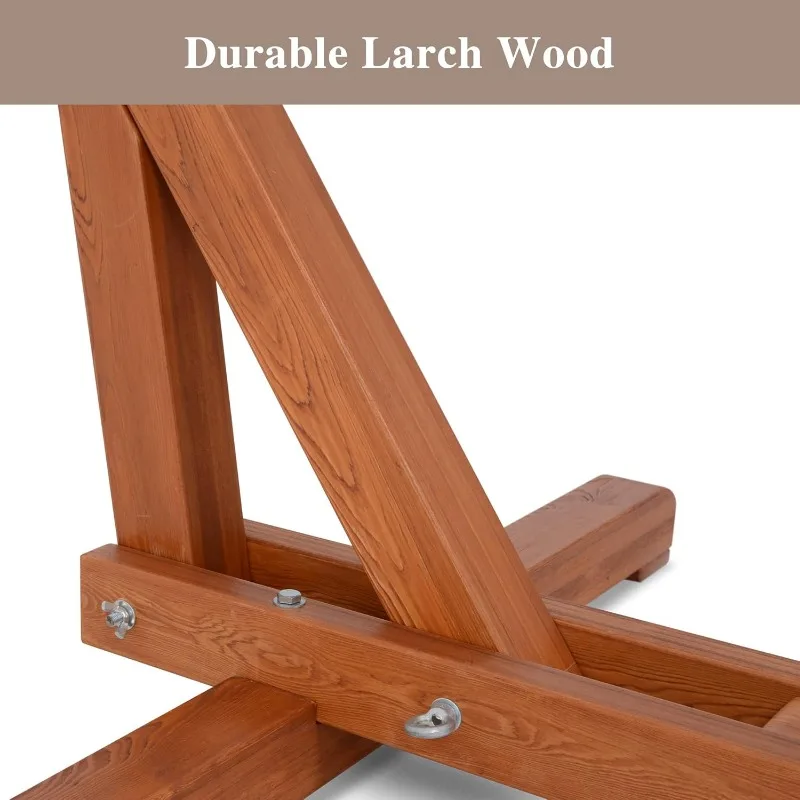
Reinforcement Techniques: Making Your Stand Rigid
Even well-designed stands benefit from additional reinforcement techniques:
- Add diagonal braces to prevent racking (sideways movement)
- Install gussets at joints to distribute forces over larger areas
- Use metal corner brackets to reinforce wooden joints
- Double up critical structural members that bear the most weight
- Add lateral supports between A-frames for stands with multiple support points
- Use proper joinery techniques like half-lap or mortise and tenon for wooden stands
The goal is to create a unified structure where forces are distributed evenly throughout the entire frame rather than concentrated at specific points.
Finishing Touches for Longevity
Proper finishing not only improves appearance but also significantly extends your stand’s lifespan and stability:
- Sand all wooden surfaces smooth to prevent splintering and water penetration
- Seal end grain thoroughly, as it’s the most vulnerable to moisture absorption
- Apply multiple coats of marine-grade varnish, exterior paint, or penetrating oil
- Use rust-inhibiting primer and paint for metal components
- Install protective caps on feet to prevent moisture absorption through ground contact
- Consider removable/washable protective covers for seasonal storage
These finishing steps protect your materials from deterioration that would eventually compromise structural integrity and stability.
Long-Term Stability: Maintaining Your A-Frame Hammock Stand
Creating a stable hammock stand is just the beginning—maintaining that stability over time requires ongoing attention. Implementing a regular maintenance routine prevents the gradual development of stability issues and extends your stand’s useful life.
The ultimate guide to A-frame hammocks covers many aspects of long-term hammock care, including stand maintenance for continued stability.
Routine Inspection Checklist
Develop a habit of performing these inspections regularly, with frequency depending on usage and exposure to elements:
Monthly checks (during active use season):
* Tighten all visible fasteners, especially at stress points
* Look for early signs of rust on metal components
* Check wood for developing cracks or splinters
* Verify that feet remain level and make contact evenly
* Ensure suspension points show no signs of wear or elongation
Seasonal checks:
* Deep clean the entire structure to remove dirt and debris
* Inspect for insect damage or nesting in wooden components
* Check for UV damage to finishes or protective coatings
* Look for ground shifting that might affect the stand’s level position
* Verify that all structural members remain straight and true
Annual maintenance:
* Completely disassemble and inspect all components
* Replace any fasteners showing corrosion or wear
* Refinish surfaces as needed to maintain weather protection
* Check hammock compatibility and suspension components
* Assess overall structural integrity against original specifications
Protecting Your Investment from the Elements
Weather exposure accelerates wear and can compromise stability over time. Different seasons present unique challenges for maintaining your hammock stand.
Summer considerations:
* Provide shade to prevent UV damage to materials
* Clean regularly to remove tree sap, bird droppings, or other substances
* Consider temporary anchors during summer storm season
Fall preparation:
* Clear accumulated leaves and debris from joints and connections
* Check for moisture retention in wooden components before winter
* Tighten all fasteners before potential freezing temperatures
Winter protection:
* Store portable stands indoors if possible
* Use waterproof covers for permanent outdoor installations
* Remove the hammock itself to reduce wind load on the structure
* Elevate feet above snow line when possible
Spring restoration:
* Thoroughly inspect for winter damage before first use
* Address any ground shifting from freeze-thaw cycles
* Apply fresh protective finishes as needed
* Re-level the stand after ground thawing
Understanding whether it’s okay to leave your hammock outside in different weather conditions helps you make informed decisions about seasonal protection.
Troubleshooting Common A-Frame Hammock Stability Problems
Even with proper setup and maintenance, you might encounter specific stability issues that need targeted solutions. This troubleshooting guide addresses the most common problems and provides practical fixes.
Issue: Stand Wobbles Excessively from Side to Side
Side-to-side wobbling creates an unsettling swaying motion perpendicular to your normal hammock motion. This lateral instability is particularly concerning as it can lead to complete tipping.
Potential causes and solutions:
* Uneven leg height: Adjust individual legs or use shims to ensure all feet contact the ground evenly
* Loose lateral bracing: Tighten or replace cross-braces that prevent side-to-side movement
* Narrow base width: Add base extenders or wider feet to increase the stability footprint
* Structural flexing: Reinforce frame with additional diagonal bracing or gussets
* Unlevel ground: Relocate to a flatter surface or use leveling blocks to create a stable base
Issue: Stand Feels Like It Might Tip Forward or Backward
Forward or backward tipping usually occurs during entry or exit or when shifting position in the hammock. This longitudinal instability is directly related to the stand’s resistance to rotational forces.
Potential causes and solutions:
* Improper hammock angle: Adjust suspension to achieve the ideal 30-degree angle
* Hammock hung too high: Lower overall height to reduce leverage forces
* Too much end-to-end rocking: Add weight to the base or feet of the stand
* Stand too tall for its base length: Modify the design to increase the base-to-height ratio
* Weak end joints: Reinforce A-frame apex connections with additional bracing
Issue: One or More Legs Sink into the Ground
When stand legs sink into soft ground, the entire geometry changes, compromising stability in multiple directions simultaneously.
Potential causes and solutions:
* Soft soil or lawn: Place flat pavers or stepping stones under each foot
* Pointed or small feet: Add foot pads to increase surface area and distribute weight
* Uneven weight distribution: Check that hammock is centered and hanging evenly
* Water-saturated ground: Move to a drier location or create a drainage solution
* Sand or loose soil: Use ground anchors in combination with wide foot pads
* Decking or soft wood surfaces: Add load-distributing plates under feet
Issue: Stand Makes Creaking or Groaning Noises
Unusual noises during hammock use often indicate developing stability issues that require attention before they worsen.
Potential causes and solutions:
* Loose fasteners: Systematically tighten all bolts, screws, and connectors
* Wood drying and shrinking: Apply moisture-resistant sealer and retighten components
* Metal components rubbing: Add washers or lubricate with appropriate products
* Wood joints separating: Reinforce with metal brackets or wood glue and clamps
* Stress fractures developing: Inspect carefully for hairline cracks and replace affected parts
* Rope or chain friction: Apply appropriate lubricant or replace with silent hanging hardware
Are A-Frame Hammock Stands Safe for Everyday Use?
A-frame hammock stands, when properly designed, set up, and maintained, are indeed safe for regular use. Their triangular design inherently distributes weight efficiently, and their self-contained nature eliminates the need for finding appropriate trees or mounting points.
However, safety depends entirely on proper setup and use. An incorrectly assembled or poorly maintained A-frame stand can present significant risks. Similarly, user behavior—like exceeding weight limits or engaging in rough play—can compromise even the most stable stand design.
The key safety advantage of A-frame stands over other options is their predictability. Unlike trees or wall mounts whose strength might be uncertain, a quality A-frame stand is specifically engineered for its purpose with known weight limits and design parameters. This makes them particularly appropriate for both indoor and outdoor use where consistent safety is a priority.
How Weather Affects Your A-Frame Hammock Stand’s Stability
Weather conditions can dramatically impact your hammock stand’s stability, with different elements presenting unique challenges:
Wind creates lateral forces that can push stands off balance, particularly when the hammock acts as a sail. Heavy rain can saturate the ground, allowing stands to sink unevenly. Temperature fluctuations cause materials to expand and contract, potentially loosening fasteners or creating gaps in joints.
Seasonal changes require different approaches to maintain stability. Summer heat may require more frequent tightening of wooden components as they dry and shrink. Winter brings freeze-thaw cycles that can heave the ground beneath outdoor stands. Spring often reveals stability issues that developed during winter storage.
Portable stands generally require more weather-related adjustments than permanent installations because they lack the settled stability that comes with time and weight. However, they offer the advantage of being easily moved to protected locations during extreme weather.
What’s Better for Stability: Wood, Metal, or Composite A-Frame Stands?
Each material offers distinct stability advantages and challenges:
Wood stands provide natural vibration dampening and typically feel more stable during normal use. Their weight helps them resist movement, and their slight flexibility absorbs minor forces without transmitting them through the structure. However, wood can warp or rot over time, gradually compromising geometric stability.
Metal stands offer precision engineering and consistent performance. They maintain their shape regardless of humidity or temperature changes, ensuring geometric stability. Their rigidity provides predictable performance but can transmit more movement to the user. Metal stands are typically lighter than wood, which can make them more susceptible to movement unless properly weighted.
Composite material stands combine aspects of both worlds, often using metal for critical structural components while incorporating wood or synthetic materials for aesthetic and comfort elements. They frequently offer excellent stability with reduced maintenance requirements.
Your environment should heavily influence your material choice. Wood performs well in dry climates with minimal humidity fluctuations. Metal excels in variable environments but requires protection from corrosion. Composite materials often provide the best all-around performance across diverse settings.

